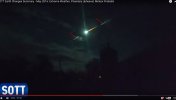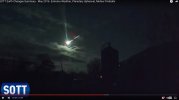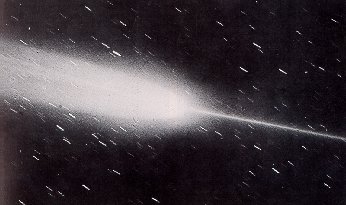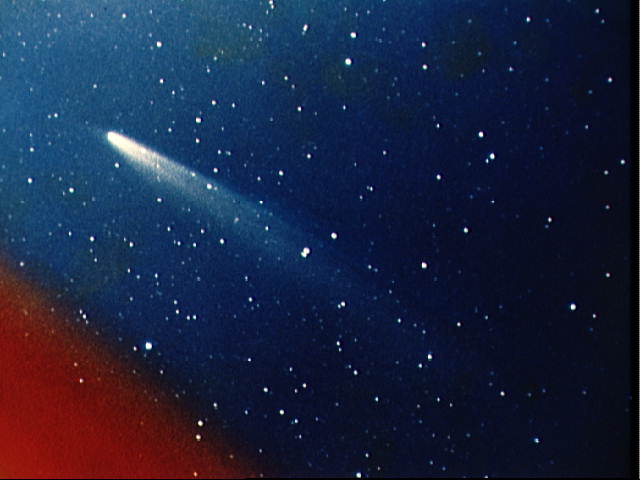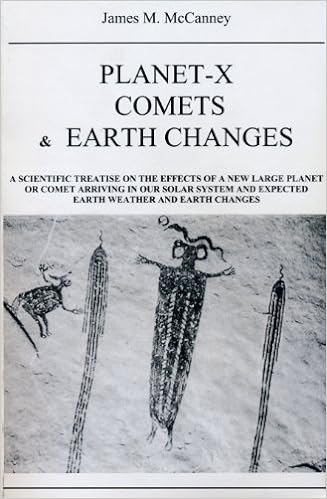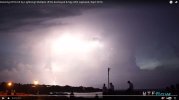If you watch this month's SOTT Earth Changes Summary video,
May 2016: Extreme Weather, Planetary Upheaval, Meteor Fireballs
https://www.sott.net/article/319812-SOTT-Earth-Changes-Summary-May-2016-Extreme-Weather-Planetary-Upheaval-Meteor-Fireballs
at the 17. May of 2016, a fireball went down across Canada/US. At time index 12:53, you will see this fireball.
It caught my eye that this fireball apparently created some kind of glowing tracks in its path BEFORE it crossed that location, and that TWICE. Now, a considerable percentage of 'unusual phenomena' in the sky that are shared on social media involve bright objects on dark backgrounds which create reflections and light scattering in and on photographic lenses -- I'm repeatedly pointing this out to people. However, this case seems different to me because a lens reflection usually is a mirror image of the primary bright object, mirrored in X and Y axes across the lens center.
And the two glowing tracks in this fireball video (marked with red arrows in the attached screenshots) seem to be an unlikely candidate for lens reflections because,
1. both glowing tracks are steady, whereas the fireball moves
2. both glowing tracks, together with the fireball, are exactly placed on a line
3. apart from the two distinct glowing tracks, the fireball does not otherwise create any other glowing tracks (red circle in the screenshot below)
Note that we DO see light scattering of the lens (the ray that goes almost vertically up and down), but that is trivial and neglectable.
As to these two glowing tracks, if they are not lens reflections, they may have been actually there. But then the question beomes, why were they created BEFORE the fireball moved through them?
In the plasma/vacuum of deep space, comets can have tails pointing in any direction (sunward spikes, etc.), but this fireball already seems to have entered atmosphere deeply with a lot of 'wind' so to say, so it seems unlikely that this particular astrophysical principle applies here.
From comet Shoemaker-Levy we know that comets can fragment into linearly aligned pieces, like a string of pearls. Maybe that was the case here? Did this fireball have smaller fragments that entered atmosphere along the same trajectory before, leaving behind ionized air that later lit up when the main piece approached?
Other explanations?
May 2016: Extreme Weather, Planetary Upheaval, Meteor Fireballs
https://www.sott.net/article/319812-SOTT-Earth-Changes-Summary-May-2016-Extreme-Weather-Planetary-Upheaval-Meteor-Fireballs
at the 17. May of 2016, a fireball went down across Canada/US. At time index 12:53, you will see this fireball.
It caught my eye that this fireball apparently created some kind of glowing tracks in its path BEFORE it crossed that location, and that TWICE. Now, a considerable percentage of 'unusual phenomena' in the sky that are shared on social media involve bright objects on dark backgrounds which create reflections and light scattering in and on photographic lenses -- I'm repeatedly pointing this out to people. However, this case seems different to me because a lens reflection usually is a mirror image of the primary bright object, mirrored in X and Y axes across the lens center.
And the two glowing tracks in this fireball video (marked with red arrows in the attached screenshots) seem to be an unlikely candidate for lens reflections because,
1. both glowing tracks are steady, whereas the fireball moves
2. both glowing tracks, together with the fireball, are exactly placed on a line
3. apart from the two distinct glowing tracks, the fireball does not otherwise create any other glowing tracks (red circle in the screenshot below)
Note that we DO see light scattering of the lens (the ray that goes almost vertically up and down), but that is trivial and neglectable.
As to these two glowing tracks, if they are not lens reflections, they may have been actually there. But then the question beomes, why were they created BEFORE the fireball moved through them?
In the plasma/vacuum of deep space, comets can have tails pointing in any direction (sunward spikes, etc.), but this fireball already seems to have entered atmosphere deeply with a lot of 'wind' so to say, so it seems unlikely that this particular astrophysical principle applies here.
From comet Shoemaker-Levy we know that comets can fragment into linearly aligned pieces, like a string of pearls. Maybe that was the case here? Did this fireball have smaller fragments that entered atmosphere along the same trajectory before, leaving behind ionized air that later lit up when the main piece approached?
Other explanations?


